Foreword: In 2016, I was awarded a U.S. Fulbright Scholar’s grant to travel and live in Ukraine–a great honor! My project is doing research on the life of the 19th century writer, Nikolai Gogol for a novel I am currently writing about him. Here is a new series of blog posts about my amazing, evolving, always fascinating, sometimes perplexing times in Ukraine.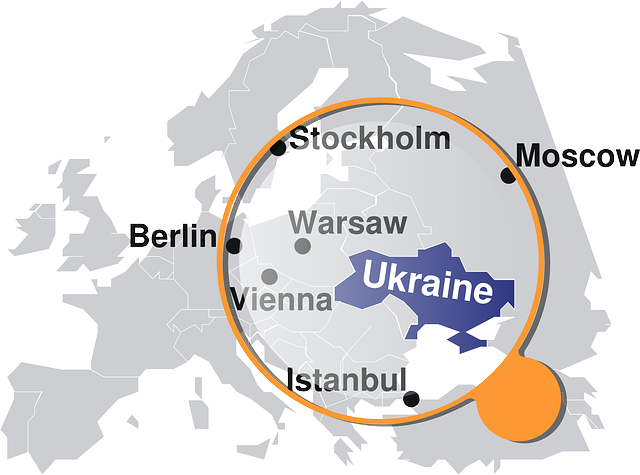
My main purpose in visiting Odesa was to walk the streets where Nikolai Gogol used to inhabit and to visit the Odesa State Literature Museum. I am an absolute literary groupie, and so any city that dedicates an entire museum to its writers—I’m there! Forget the hour boat ride on the Black Sea, or the “Odesa Criminals” tour (I’ll do those another time), but for me, bring on the Literature Museum!
And what a place! It’s an absolute palace (the original owner was a prince after all). None of the writers whose personal effects and books on display in the galleries could ever have afforded to live there—well, maybe Pushkin but he had his own apartment not too far away, and incidentally, Odesa has another museum dedicated only to him.
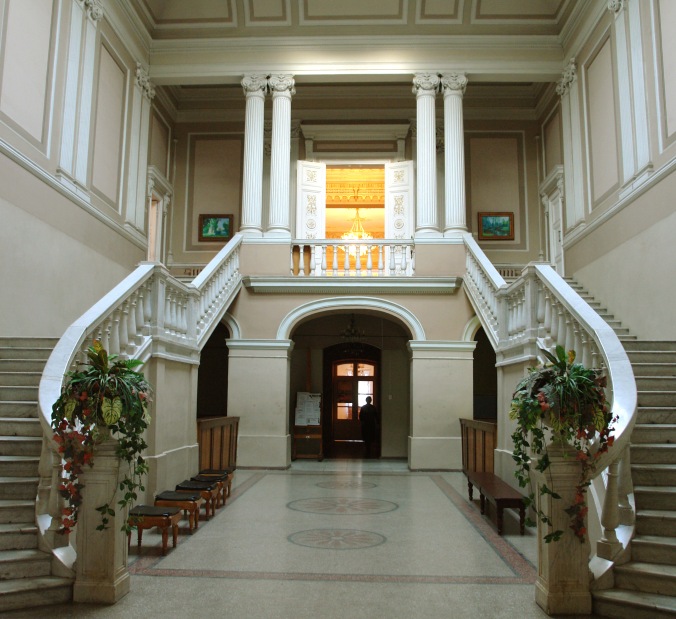
Main entrance hallway, Odesa State Literature Museum, Odesa, Ukraine (Photo: website).
I visited the Literature Museum twice on two separate occasions. The first was rhapsodic, delightful, dreamy, and fabulous (I could have written an ode to it). The second—well, it was odious overall—not the Museum of course, but the fact that everything on that trip (which will be a pun in a minute) went wrong for all sorts of unfathomable, even karmic reasons culminating in my falling off the stairs at the Museum entrance while filming the exterior, and breaking my ankle. I ignored my accident and pain until ten days later when I succumbed to going to a doctor in Kyiv and was then bivouacked there for the entire winter (more about Kyiv in an upcoming post).
But forget that—I have now that it is Spring, and my leg cast is off, and I am skipping around Ukraine again. Let’s return to that first lovely visit where I was captivated by the idea that 300 great writers like Pushkin, Bunin, Chekhov, Lesya Ukrainka, Ahkmatova, Babel and Gogol too–have been memorialized and honored in that glorious breathtaking building because they had been to Odesa and Odesa still shows them off in a grand place.
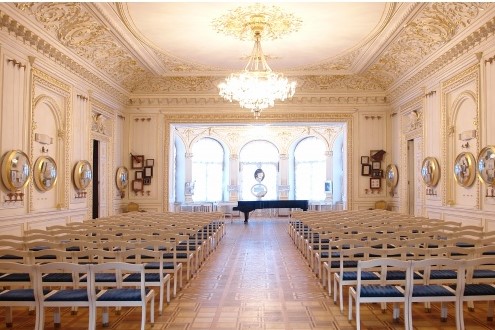
Concert hall, Odesa State Literature Museum, Odesa, Ukraine (Photo: website)
There is an exhibit dedicated to Gogol although it’s in rather a dark, eerie section in one of the lovely rooms. Above hangs a Ukrainian dress tacked on to the ceiling to represent the whimsical flying characters in his first collection of short stories, Evenings on a Farm Near Dikanka. In the glass case are rare copies of his books, and a hand written account by someone who actually saw and heard him do a public reading in Odesa. That was thrilling!
Why was Gogol in Odesa? As I mentioned in my previous post, Gogol’s sister Elizaveta announced her intentions to marry when Gogol was visiting his mother and sisters at his home in Sorochintsy (near Poltava), Ukraine. He could not stand all the preparations and fuss being made. Actually, he had an aversion to marriage in general, never having been married himself (although he came close once). He decided to escape his family’s acting like “besotted kittens” over the wedding plans, and journeyed to Odesa in his battered coach despite the autumnal torrential rainfalls of 1850.
Once in Odesa, Gogol stayed at the home of his rich cousin Andrie Troschinsky who wasn’t around at the time, and so Gogol found himself being entertained by Princess Varvara Repnina, an old friend who also had a mansion in the neighborhood.
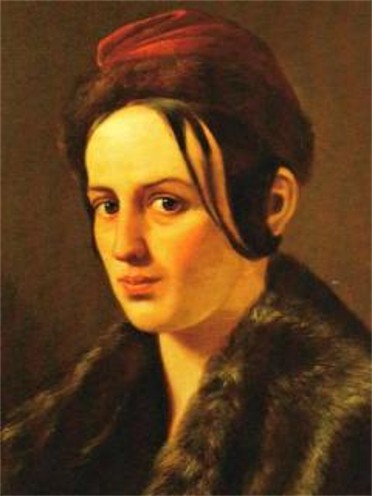
Portrait of Princess Varvara Repnina (1809-1891) by H. Psiol
Princess Varvara deserves a book of her own. She’s a fascinating character whose famous aristocratic family was often kindly disposed towards Ukrainians. She in particular was enamored (and in love) with the national Ukrainian poet (and Gogol’s contemporary) Taras Shevchenko who was a serf at the time, and she very much older. Nothing came of it except a long and loyal friendship, and Varvara tried very hard to get the Tsar to release Shevchenko from his harsh exile after his arrest for “inciting the Little Russians.”
Ah, but back to Gogol and Varvara who met many years before in Baden-Baden where Gogol was taking in “the water cures” for his usual phantom illnesses. While in Odesa, the Princess and Gogol attended the plays at the Horodskoy Theatre and Opera House where she owned a private box. Gogol had her permission to use it on his own whenever he liked, which was nearly every night of a performance.
This was a wonderful godsend for Gogol who loved the theatre although he had terrible experiences with actors when his first play The Inspector General was performed in St. Petersburg. He was also depressed over the tumultuous backlash against what was to be his last published book, Selected Passages from Correspondences with Friends, followed by a disappointing trip to the Holy Land, several illnesses, and his usual dismal pecuniary situation.
But he loved to sit at the Horodskoy, by all accounts a beautiful theatre before it burned down in 1873. Gogol especially enjoyed and attended several performances of Molière plays which were among his favorites.
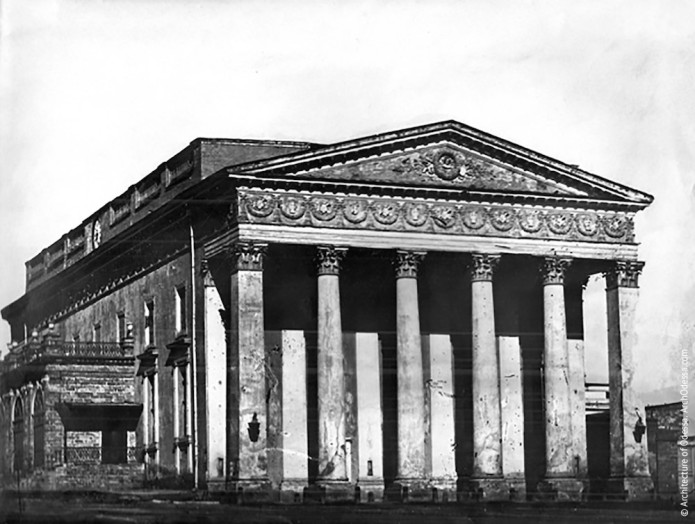
The Horodskoy Theatre and Opera House, Odesa, Ukraine (Archival photo).
One night after a performance, he went to a nearby restaurant called the Otona where he was approached by some of the Horodskoy actors. He was defensive at first, assuming that they would mock him the way the St. Petersburg actors did when he tried to instruct them on stage performing. But no, these actors were humble and in complete awe of Gogol–even asking him for pointers about their performance which he gladly gave.
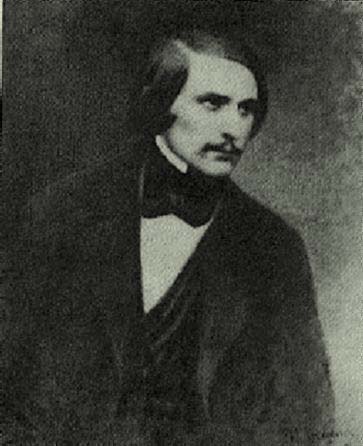
The only known Daguerreotype of Nikolai Gogol, taken in Rome 1845 probably by Sergei Levitsky (Archival photo).
Gogol and the actors met up regularly afterwards—he even made his famous macaroni dish for them (with rum—a recipe he invented when living in Rome), and was gratified to finally have a group of people who respected his intelligence and sanity after the horrific criticisms he received for that unfortunate last book.
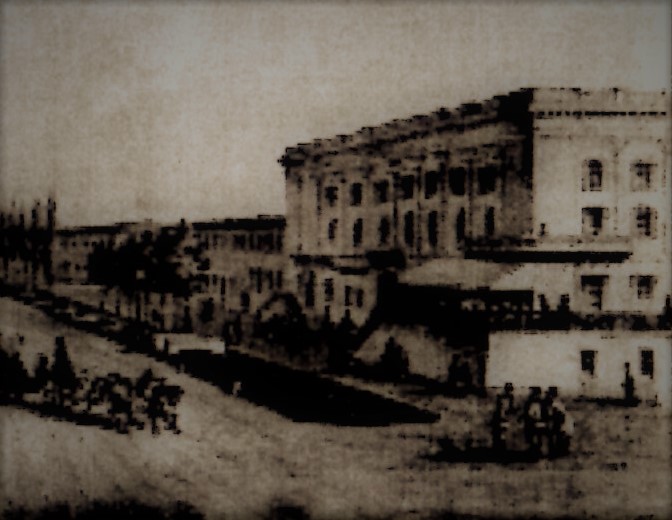
Building where the Otona Restaurant was located, Odesa, Ukraine (Archival graphic).
It was probably the most appreciated he ever felt in the last years of his life before he left Ukraine to return to Moscow where his sad life ended in 1852.
But for now, I will leave him in Odesa, lecturing to the rapt listeners in that candle-lit restaurant kitchen. He resembles a mystical shaman by the way he is clattering two wooden spoons in a pan while stirring the macaroni and rum together. Soon he will sprinkle special Parmigiano cheese he always keeps in a vest pocket before dishing out the pasta to the actors. They are the audience here, and they cannot take their eyes off Gogol reciting the lines from the plays he performed in when he was a Ukrainian school boy so long ago.
Thanks to my hosts and guides at the Odesa State Literature Museum for the special tour and information shared about Gogol in Odesa.
LINKS:
Fulbright Scholar Program: www.cies.org/
Odesa State Literature Museum: http://www.odessatourism.org/en/do/museums/literary-museum,
My Website: www.irenezabytko.com
NEXT POST: Gogol in Scotland.
Need help and inspiration in writing GREAT fiction? Find both in my writing guidebook: THE FICTION PRESCRIPTION: HOW TO WRITE AND IMPROVE YOUR FICTION LIKE THE GREAT LITERARY MASTERS. Available at: www.irenezabytko.com and http://amzn.to/211kQhZ
Copyright © 2017 by Irene Zabytko. All rights reserved.
Great blog, glad your leg is better.
LikeLike
Thanks, Laurie. Much better these days.
LikeLike